The stages of the Super Flower Blood Moon lunar eclipse of 2022 explained
Here is every stage of the Super Flower Blood Moon of May 15 with a timetable for the total lunar eclipse.
Total eclipses of the moon are the most colorful of all astronomical phenomena.
Each lunar eclipse is unique, with its brightness and coloration determined by a range of factors, such as the geometry of the eclipse and the large-scale meteorological conditions on Earth. When the moon is entering, and later emerging from, Earth's shadow, secondary phenomena may be overlooked.

Looking for a telescope for the lunar eclipse? We recommend the Celestron Astro Fi 102 as the top pick in our best beginner's telescope guide.
To help prepare for the upcoming total lunar eclipse of May 15-16, Space.com's Joe Rao — a veteran of 19 total lunar eclipses — has prepared a chronology, including some of the things you might see. However, you may not glimpse everything mentioned here, because no two eclipses are exactly the same.
But many of these phenomena will indeed be visible, and observers who know what to look for will have a better chance of seeing the various stages. If the eclipsed moon is below the horizon in your location, or if bright lights or cloudy skies impede your view, you can check out a webcast of the event. Here's how to watch the Blood Moon total lunar eclipse online.
The May full moon is known as the Flower Full Moon and is occurring when the moon is near perigee, its closest point to the Earth for the month, making it also a so-called supermoon as it can appear slightly larger than when the moon is at its farthest from Earth.
Related: Super Flower Blood Moon lunar eclipse: Is it the 1st of 4 supermoons?
The Super Flower Blood Moon stages
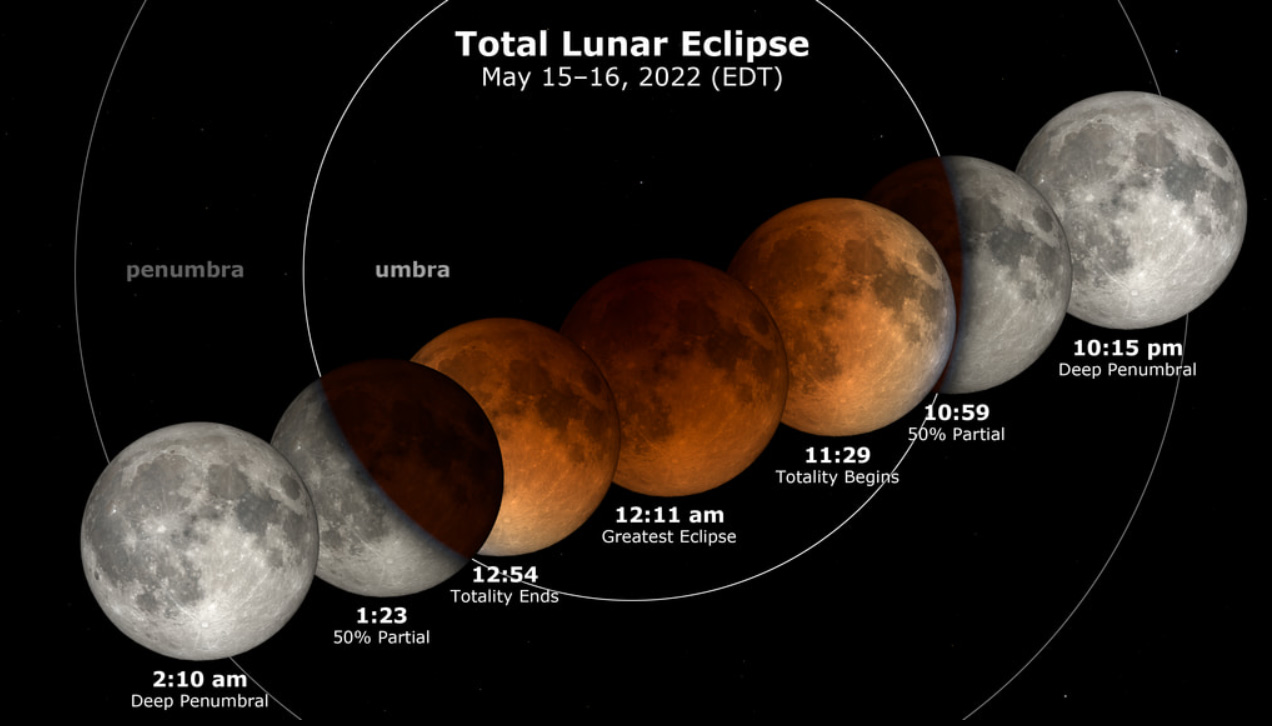
| Stage | GMT | ADT | EDT | CDT | MDT | PDT | AKDT | HST |
|---|---|---|---|---|---|---|---|---|
| 1) Moon enters penumbra | 01:31 a.m. | 10:31 p.m. | 9:31 p.m. | 8:31 p.m. | ---- | ---- | ---- | ---- |
| 2) Penumbral shadow appears | 02:10 a.m. | 11:10 p.m. | 10:10 p.m. | 9:10 p.m. | 8:10 p.m. | ---- | ---- | ---- |
| 3) Moon enters umbra | 02:28 a.m. | 11:28 p.m. | 10:28 p.m. | 9:28 p.m. | 8:28 p.m. | ---- | ---- | ---- |
| 4) 75% coverage | 03:13 a.m. | 12:13 a.m. | 11:13 p.m. | 10:13 p.m. | 9:13 p.m. | 8:13 p.m. | ---- | ---- |
| 5) Five minutes to totality | 03:25 a.m. | 12:25 a.m. | 11:25 p.m. | 10:25 p.m. | 9:25 p.m. | 8:25 p.m. | ---- | ---- |
| 6) Total eclipse begins | 03:29 a.m. | 12:29 a.m. | 11:29 p.m. | 10:29 p.m. | 9:49 p.m. | 8:49 p.m. | ---- | ---- |
| 7) Middle of totality | 04:12 a.m. | 1:12 a.m. | 12:12 a.m. | 11:12 p.m. | 10:12 p.m. | 9:12 p.m. | ---- | ---- |
| 8) Total eclipse ends | 04:54 a.m. | 1:54 a.m. | 12:54 a.m. | 11:54 p.m. | 10:54 p.m. | 9:54 p.m. | ---- | 6:54 p.m. |
| 9) 75% coverage | 05:12 a.m. | 2:12 a.m. | 1:12 a.m. | 12:12 a.m. | 11:12 p.m. | 10:12 p.m. | 9:12 p.m. | 7:12 p.m. |
| 10) Moon leaves umbra | 05:56 a.m. | 2:56 a.m. | 1:56 a.m. | 12:56 a.m. | 11:56 p.m. | 10:56 p.m. | 9:56 p.m. | 7:56 p.m. |
| 11) Penumbral shadow fades | 06:12 a.m. | 3:12 a.m. | 2:12 a.m. | 1:12 a.m. | 12:12 a.m. | 11:12 p.m. | 10:12 p.m. | 8:12 p.m. |
| 12) Moon leaves penumbra | 06:52 a.m. | 3:52 a.m. | 2:52 a.m. | 1:52 a.m. | 12:52 a.m. | 11:52 p.m. | 10:52 p.m. | 8:52 p.m. |
In the above timetable, local circumstances are provided for eight time zones. Dashes indicate that the moon has not yet risen above the horizon.
Here's a breakdown of the stages of the blood moon total lunar eclipse and what you might see during each one:
1) The moon enters the penumbral shadow
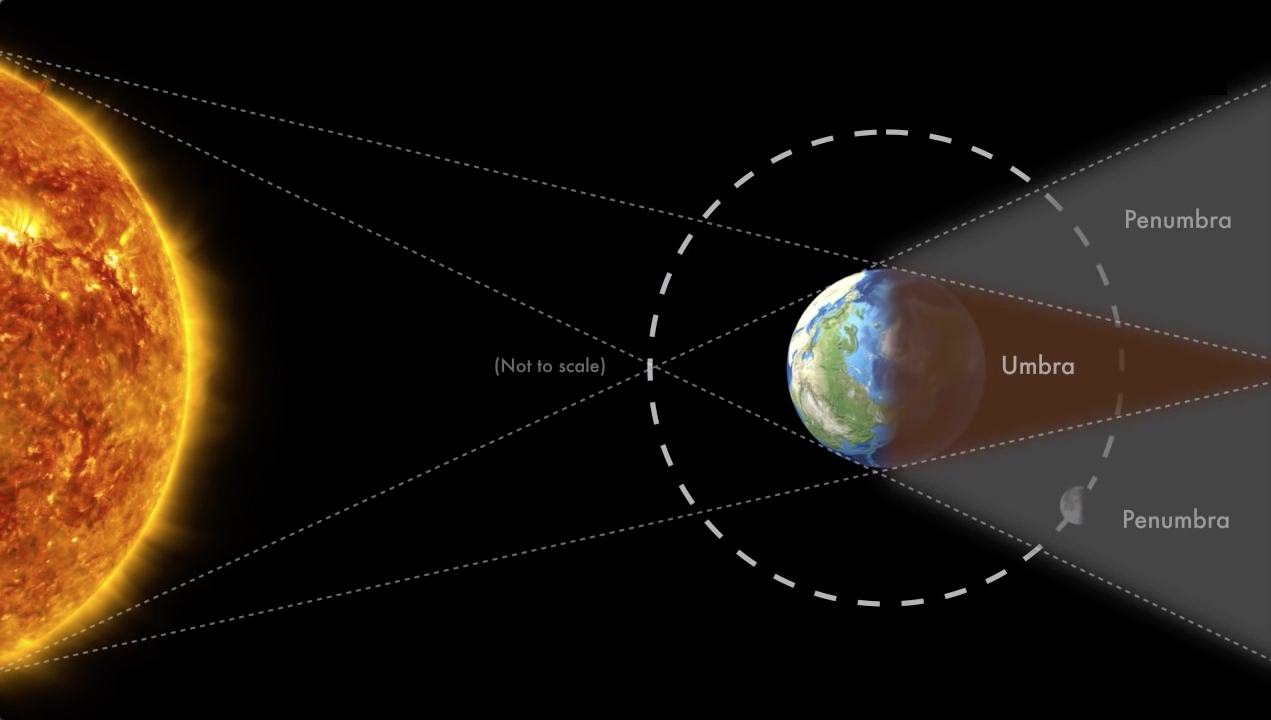
The shadow cone of the Earth has two parts: a dark, inner umbra, surrounded by a lighter penumbra. The penumbra is the pale outer portion of Earth's shadow. Although the eclipse begins officially at this moment, you won't see anything unusual happening to the moon yet. Earth's penumbral shadow is so faint that it remains invisible until the moon is deeply immersed in it, when the penumbra has reached roughly 70% across the moon's disk. For about the next 40 minutes, the full moon will continue to appear to shine normally, but with each passing minute, it is progressing ever deeper into Earth's outer shadow.
2) Earth's penumbral shadow appears
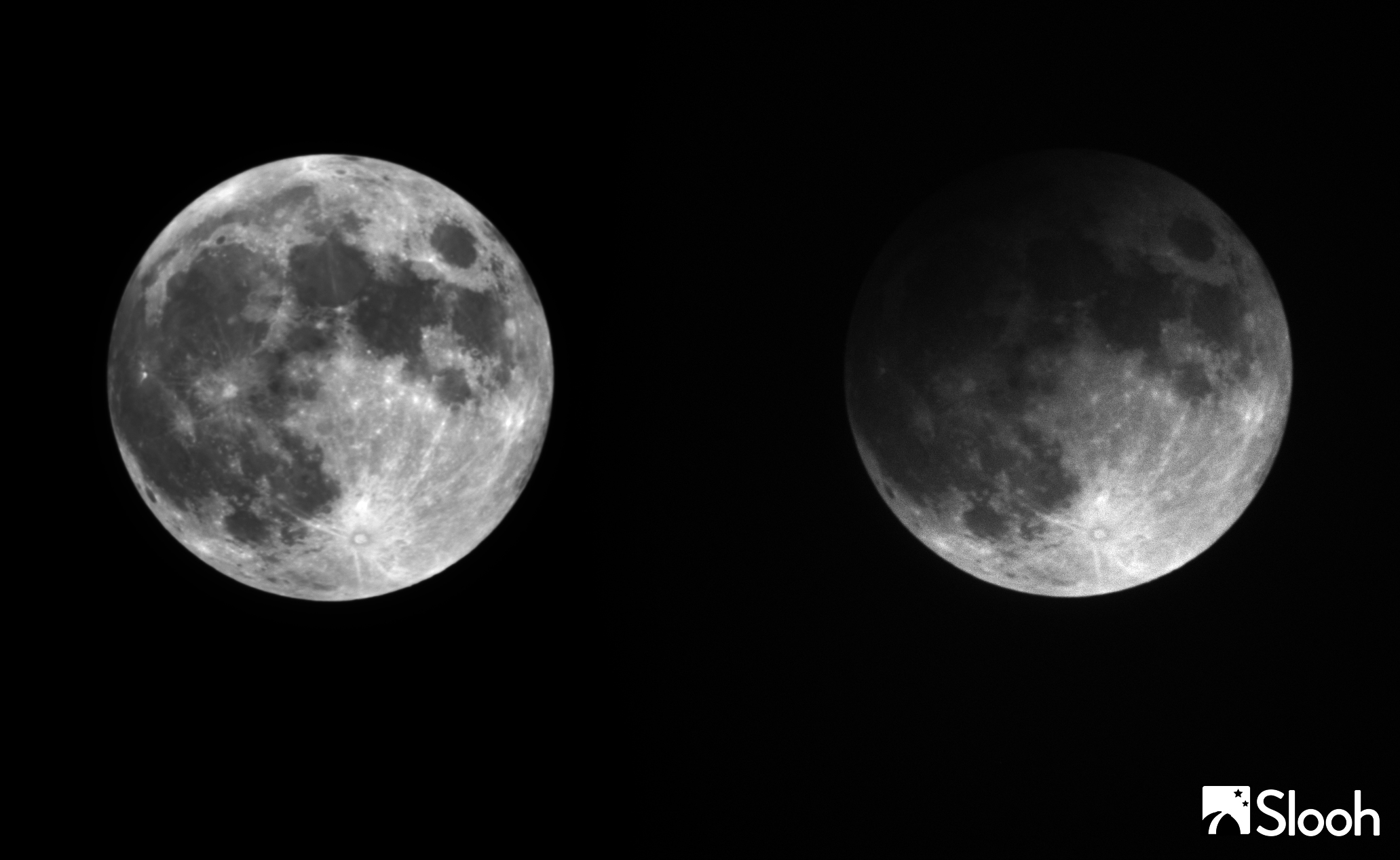
Now, the moon has progressed far enough into the penumbra that it should be evident on the moon's disk. Start looking for a very subtle light shading to appear on the moon's left portion. This will become increasingly evident as the minutes pass, with the shading appearing to spread and deepen. Just before the moon begins to enter Earth's dark umbral shadow, the penumbra should appear as an obvious smudge or tarnishing of the moon's left portion.
3) The moon enters Earth's umbral shadow
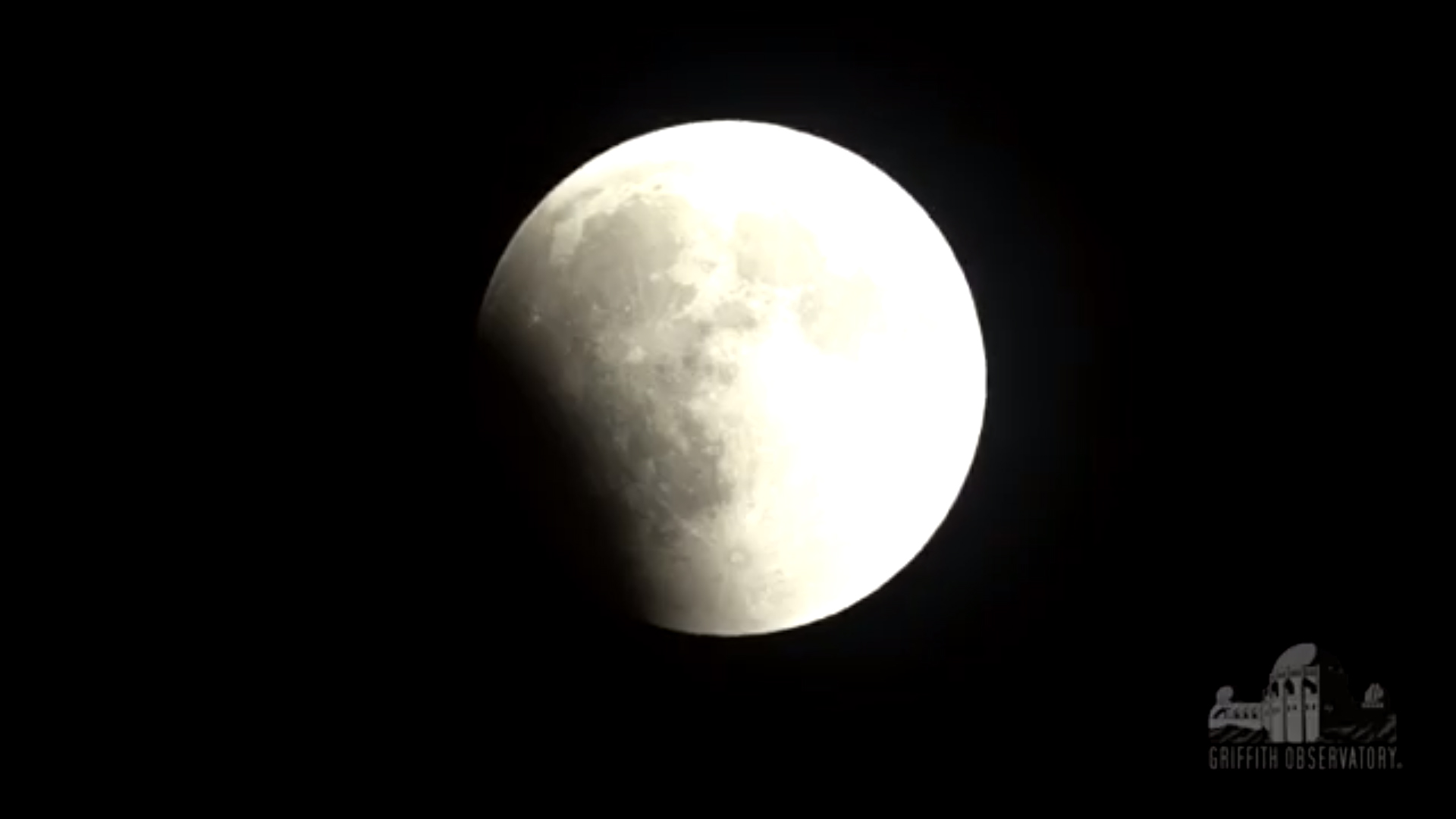
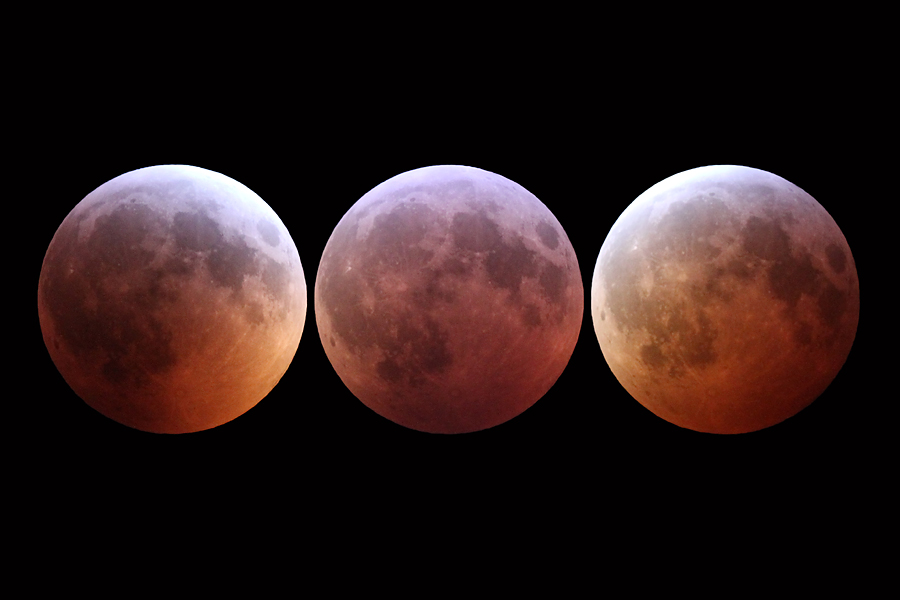
If you take a photo of the 2021 total lunar eclipse let us know! You can send images and comments to spacephotos@space.com.
The moon now begins to cross into Earth's dark central shadow, called the umbra. A small, dark scallop begins to appear on the moon's lower-left (southeastern) limb. The partial phases of the eclipse begin; the pace quickens, and the change is dramatic. The umbra is much darker than the penumbra and fairly sharp-edged. As the minutes pass, the dark shadow appears to slowly creep across the moon's face. At first, the moon's limb may seem to vanish completely inside the umbra. But much later, as it moves in deeper, you'll probably notice the moon glowing dimly orange, red or brown. Also notice that the edge of Earth's shadow projected on the moon is curved — visible evidence that Earth is a sphere (or, more precisely, an oblate spheroid), as deduced by Aristotle from lunar eclipses he observed in the fourth century B.C. It's almost as if a dimmer switch were slowly being turned down on the surrounding landscape and deep shadows of a brilliant moonlit night were beginning to fade away.
Across the western U.S. and Canada, the moon will already be partially immersed in the umbra. The low, partially eclipsed moon in deep blue twilight should offer a wide variety of interesting scenic possibilities for both artists and astrophotographers.
Related: How to photograph a lunar eclipse
4) The moon is 75% covered
With three-quarters of the moon's disk now eclipsed, the part of it that is immersed in shadow should begin to light up very faintly, similar to a piece of iron heated to the point where it just begins to glow. It now becomes obvious that the umbral shadow is not complete darkness.
In binoculars or a telescope, the outer portion is usually light enough to reveal lunar seas and craters. But the central part is much darker, and sometimes, no surface features are recognizable. Colors in the umbra vary greatly from one eclipse to the next; reds and grays usually predominate, but sometimes, there are browns, blues and other tints.
5) Less than five minutes to totality
Several minutes before (and after) totality, the contrast between the remaining pale-yellow sliver and the ruddy-brown coloration spread over the rest of the moon's disk may produce a beautiful phenomenon sometimes called the Japanese lantern effect, a term first coined by astrophotographer Peter A. Leavens in the 1950s.
6) Total eclipse begins

When the last of the moon enters the umbra, the total eclipse begins. How the moon will appear during totality is not known. During some eclipses, it appears such a dark gray or black that the moon nearly vanishes from view. With other eclipses, it can glow bright orange. The reason the moon can be seen at all when it's totally eclipsed is that sunlight is scattered and refracted around the edge of the Earth by our planet's atmosphere. To an astronaut standing on the moon during totality, the sun would be hidden behind a dark Earth outlined by a brilliant red ring consisting of all the world's sunrises and sunsets. The brightness of this ring around Earth depends on global weather conditions and the amount of dust suspended in the air. A clear atmosphere on Earth means a bright lunar eclipse. If a major volcanic eruption has injected particles into the stratosphere during the past couple of years, the eclipse is very dark.
And indeed, on Jan. 15, there was such an event: the eruption of Hunga Tonga–Hunga Ha'apai, a submarine volcano in Tonga, an archipelago in the southern Pacific Ocean. Whether this eruption injected enough ash into the stratosphere to cause the upcoming eclipse to appear unusually dark is a question that we won't be able to answer until eclipse night.
For northwestern Oregon, the western half of Washington state, much of British Columbia and the Hawaiian Islands, the moon will rise in total eclipse. Observers in these areas will likely have to wait until the twilight sky darkens and the moon has climbed sufficiently above the east-southeast horizon for their first view of the darkened lunar disk. Observers in Hawaii probably will not make a sighting until after the moon begins to emerge from the umbral shadow.
Related: Why does the moon turn red during a total lunar eclipse?
7) Middle of totality
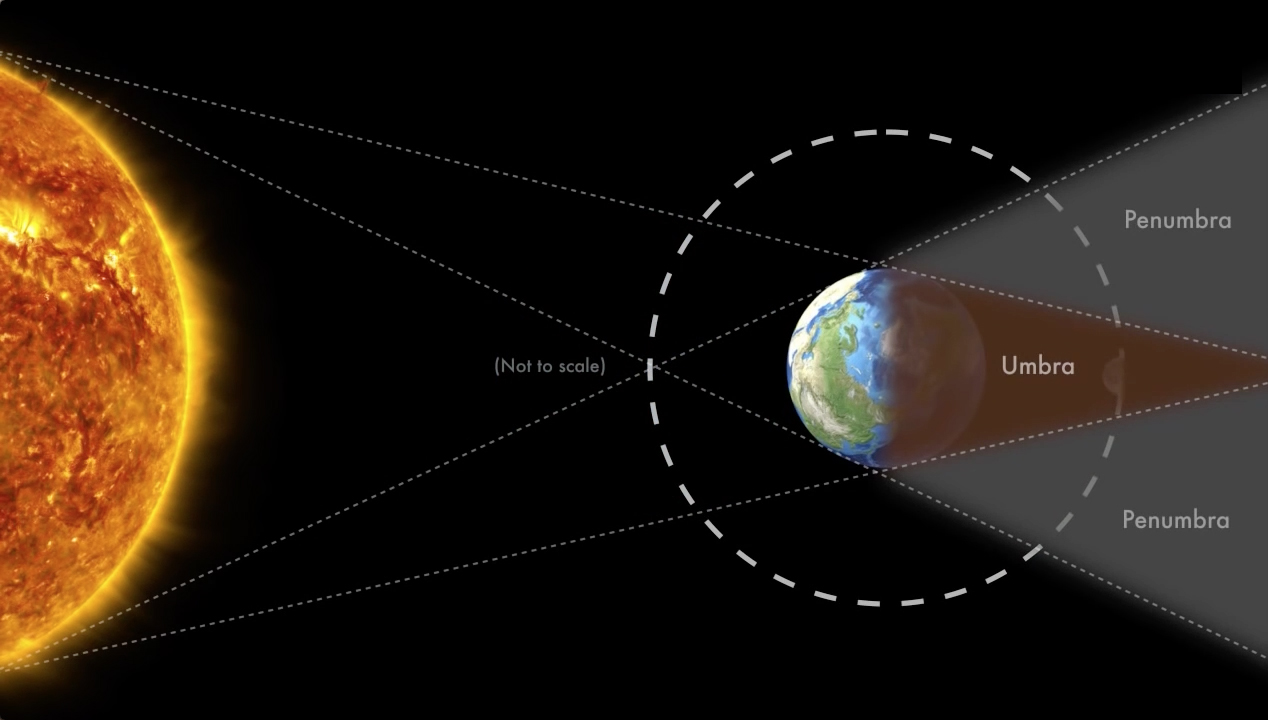
The moon is now shining anywhere from 10,000 to 100,000 times fainter than it was just a couple of hours ago. Because the moon is moving to the south of the center of Earth's umbra, the gradation of color and brightness across the moon's disk should be such that its upper portion appears darkest, with hues of deep copper or chocolate brown. Meanwhile, its lower portion — the part of the moon closest to the outer edge of the umbra — should appear brightest, with hues of reds, oranges and even perhaps a soft bluish-white. Observers away from bright city lights will notice many more stars than were visible earlier in the night.
The moon will appear in the constellation Libra (the Scales), with the entire retinue of bright summer stars and constellations spread out to the north and east of the moon. In the 2022 Observer's Handbook of the Royal Astronomical Society of Canada, retired NASA astronomer Fred Espenak noted that in 1982, he watched another total lunar eclipse with the moon in nearly the same part of the sky. "I was amazed how brilliantly the summer Milky Way glowed since it was all but invisible during the partial stages," he said.
The darkness of the sky during totality is indeed impressive. The surrounding landscape has taken on a somber hue. Before the eclipse, the full moon looked flat and one-dimensional. During totality, however, it looks smaller and three-dimensional — almost translucent, like some weirdly illuminated ball suspended in space.
Before the moon entered Earth's shadow, the temperature on its sunlit surface hovered at 261 degrees Fahrenheit (127 degrees Celsius). Because the moon lacks an atmosphere, there is no way that this heat could be retained from escaping into space as the shadow sweeps by. Now, in shadow, the temperature on the moon has dropped to minus 146 F (minus 99 C) — a drop of 407 F (226 C) in just over an hour!
8) Total eclipse ends
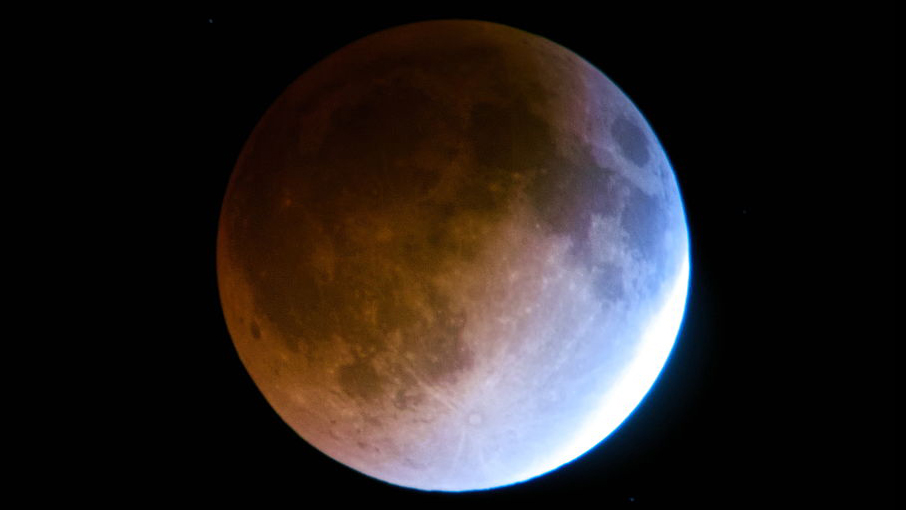
The emergence of the moon from the shadow begins. The first small segment of the moon begins to reappear, followed again for the next several minutes by the Japanese lantern effect.
For Alaska, only observers in the southeast part of the state will see the eclipse, and only as the moon is gradually emerging from the umbral shadow. Unfortunately, for the rest of the Great Land State, the moon will be below the horizon during the entire eclipse.
9) The moon is 75% covered
Any vestiges of coloration within the umbra should be disappearing now. From here on, as the dark shadow methodically creeps off the moon's disk, it should appear black and featureless.
10) Moon leaves umbra
The dark central shadow clears the moon's right-hand (western) limb.
11) Penumbral shadow fades away
As the last faint shading vanishes off the moon's right portion, the show comes to an end.
12) Moon leaves penumbra
The eclipse officially ends, as the moon is completely free of the penumbral shadow.
Editor's Note: If you snap an amazing lunar eclipse photo (or your own eclipse webcast) and would like to share it with Space.com's readers, send your photo(s), comments, and your name and location to spacephotos@space.com.
Joe Rao serves as an instructor and guest lecturer at New York's Hayden Planetarium. He writes about astronomy for Natural History magazine, the Farmers' Almanac and other publications. Follow us on Twitter @Spacedotcom and on Facebook.
Join our Space Forums to keep talking space on the latest missions, night sky and more! And if you have a news tip, correction or comment, let us know at: community@space.com.
Get the Space.com Newsletter
Breaking space news, the latest updates on rocket launches, skywatching events and more!

Joe Rao is Space.com's skywatching columnist, as well as a veteran meteorologist and eclipse chaser who also serves as an instructor and guest lecturer at New York's Hayden Planetarium. He writes about astronomy for Natural History magazine, Sky & Telescope and other publications. Joe is an 8-time Emmy-nominated meteorologist who served the Putnam Valley region of New York for over 21 years. You can find him on Twitter and YouTube tracking lunar and solar eclipses, meteor showers and more. To find out Joe's latest project, visit him on Twitter.










